Intel Introduces "Ruler" Server SSD Form-Factor: SFF-TA-1002 Connector, PCIe Gen 5 Ready
by Billy Tallis on August 9, 2017 3:00 PM EST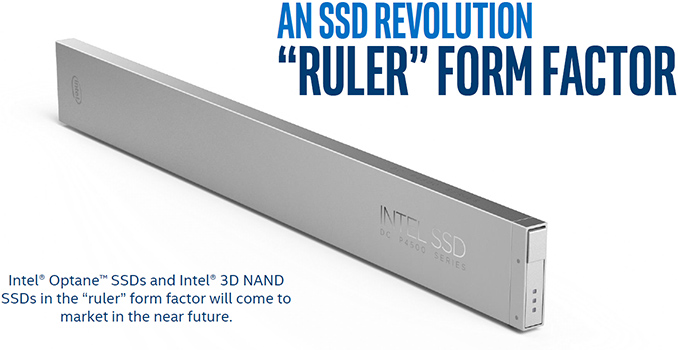
Intel on Tuesday introduced its new form-factor for server-class SSDs. The new "ruler" design is based on the in-development Enterprise & Datacenter Storage Form Factor (EDSFF), and is intended to enable server makers to install up to 1 PB of storage into 1U machines while supporting all enterprise-grade features. The first SSDs in the ruler form-factor will be available “in the near future” and the form-factor itself is here for a long run: it is expandable in terms of interface performance, power, density and even dimensions.
For many years SSDs relied on form-factors originally designed for HDDs to ensure compatibility between different types of storage devices in PCs and servers. Meanwhile, the 2.5” and the 3.5” form-factors are not always optimal for SSDs in terms of storage density, cooling, and other aspects. To better address client computers and some types of servers, Intel developed the M.2 form-factor for modular SSDs several years ago. While such drives have a lot of advantages when it comes to storage density, they were not designed to support such functionality as hot-plugging, whereas their cooling is a yet another concern. By contrast, the ruler form-factor was developed specifically for server drives and is tailored for requirements of datacenters. As Intel puts it, the ruler form-factor “delivers the most storage capacity for a server, with the lowest required cooling and power needs”.
From technical point of view, each ruler SSD is a long hot-swappable module that can accommodate tens of NAND flash or 3D XPoint chips, and thus offer capacities and performance levels that easily exceed those of M.2 modules.
The initial ruler SSDs will use the SFF-TA-1002 "Gen-Z" connector, supporting PCIe 3.1 x4 and x8 interfaces with a maximum theoretical bandwidth of around 3.94 GB/s and 7.88 GB/s in both directions. Eventually, the modules could gain an x16 interface featuring 8 GT/s, 16 GT/s (PCIe Gen 4) or even 25 - 32 GT/s (PCIe Gen 5) data transfer rate (should the industry need SSDs with ~50 - 63 GB/s throughput). In fact, connectors are ready for PCIe Gen 5 speeds even now, but there are no hosts to support the interface.
One of the key things about the ruler form-factor is that it was designed specifically for server-grade SSDs and therefore offers a lot more than standards for client systems. For example, when compared to the consumer-grade M.2, a PCIe 3.1 x4-based EDSFF ruler SSD has extra SMBus pins for NVMe management, additional pins to charge power loss protection capacitors separately from the drive itself (thus enabling passive backplanes and lowering their costs). The standard is set to use +12 V lane to power the ruler SSDs and Intel expects the most powerful drives to consume 50 W or more.
Servers and backplanes compatible with the rulers will be incompatible with DFF SSDs and HDDs, as well as with other proprietary form-factors (so, think of flash-only machines). EDSFF itself has yet to be formalized as a standard, however the working group for the standard already counts Dell, Lenovo, HPE, and Samsung as among its promotors, and Western Digital as one of several contributors.
It is also noteworthy that Intel has been shipping ruler SSDs based on planar MLC NAND to select partners (think of the usual suspects - large makers of servers as well as owners of huge datacenters) for about eight months now. While the drives did not really use all the advantages of the proposed standard – and I'd be surprised if they were even compliant with the final standard – they helped the EDSFF working group members prepare for the future. Moreover, some of Intel's partners have even added their features to the upcoming EDSFF standard, and still other partners are looking at using the form factor for GPU and FPGA accelerator devices. So it's clear that there's already a lot of industry interest and now growing support for the ruler/EDSFF concept.
Finally, one of the first drives to be offered in the ruler form-factor will be Intel’s DC P4500-series SSDs, which feature Intel’s enterprise-grade 3D NAND memory and a proprietary controller. Intel does not disclose maximum capacities offered by the DC P4500 rulers, but expect them to be significant. Over time Intel also plans to introduce 3D XPoint-based Optane SSDs in the ruler form-factor.
Related Reading:
Source: Intel


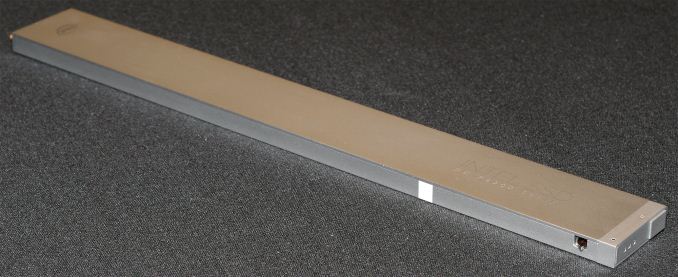
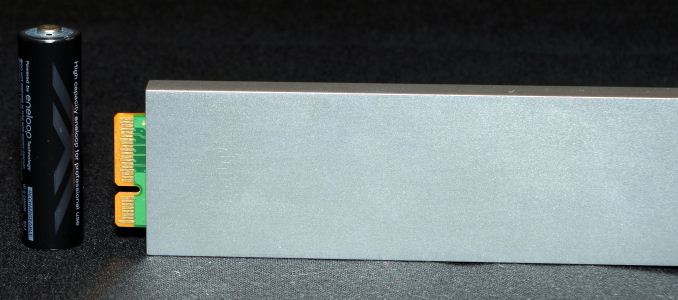
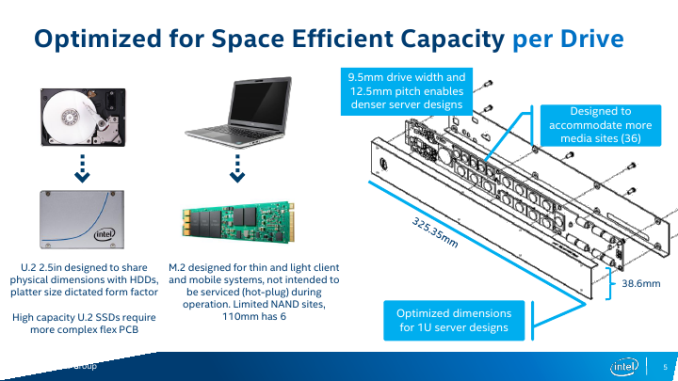
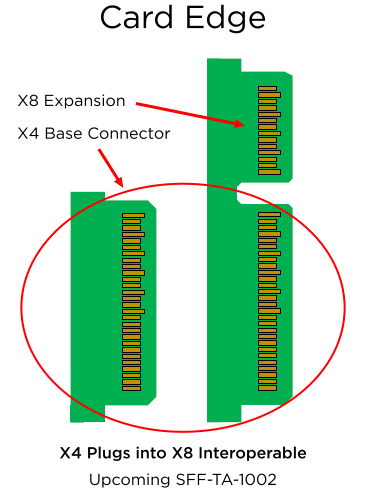
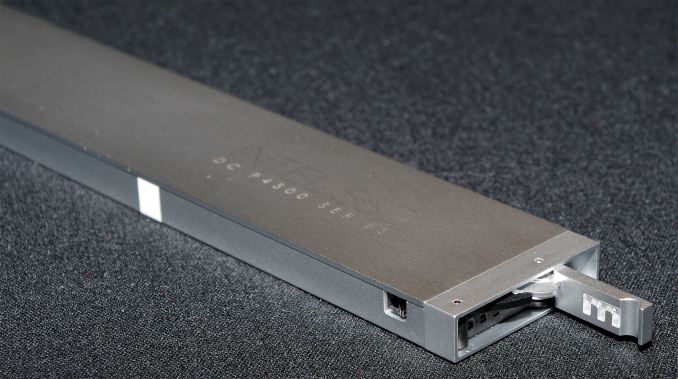
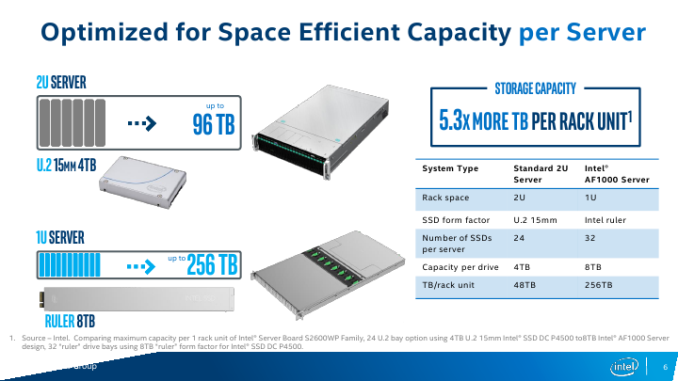
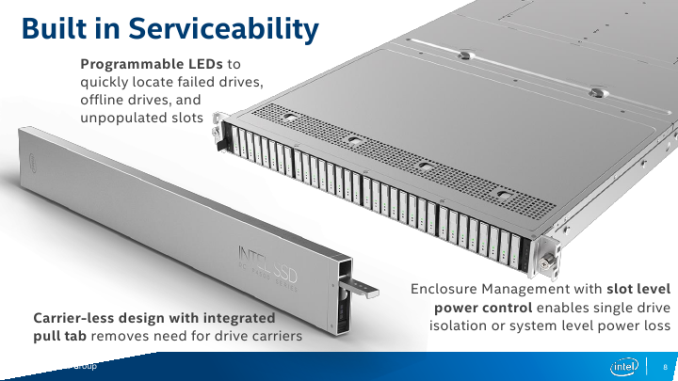














50 Comments
View All Comments
surt - Wednesday, August 9, 2017 - link
According to the article, they specify a pitch between units which would seem to allow for between-blade (ruler) air cooling.ddriver - Thursday, August 10, 2017 - link
"Or would you pack them in like sardines, and let them bake as if in an oven?"That's pretty much the plan. This solution WILL NOT COOL WELL. It will however allow for a substantial amount of heat to sink in, and when it saturates, drives will begin to throttle, killing your performance.
Additionally, having the drives bake and sweat in heat throughout their entire lifetime will be a real help when designing drives to fail as soon as possible after their warranty period expires. If corporations like intel hate something, that is products which continue being operational for years after their warranty runs out. Rather than people lining up to buy new hardware and generating as much profit as possible.
Like I already said, it is a decorated money grab. It is possible to have solutions superior to this in every way, while still retaining compatibility with the perfectly adequate 2.5" form factor.
flgt - Thursday, August 10, 2017 - link
The individual drive seems better thermally since all dies have a direct thermal path to the outer cover and the cover provides a lot of surface area for cooling air to flow over. My worry is if this is enough to overcome the total heat density that can now be achieved. If the air flow is front to back the victims may be the circuitry in the back and not the drives since they will see the elevated air temperatures created by the drives. I have to believe someone looked at all that though.HStewart - Wednesday, August 9, 2017 - link
Well if you combine this with directions of Intel's Compute Card, you see something interesting modular upgrading of components and expansion. But keep in mind the Compute Card are not high end components - but it might point to future plans for Intel - for many Compute Card based server in small amount space.My guess this is going quite expensive - but there are many that need this amount storage - but then again at my first job we have a machine with 24M of memory and 1G of storage and that was pretty much unheard of in PC world in 1992.
ddriver - Thursday, August 10, 2017 - link
Let's hear it for convenience.The compute card blows up a 2 cent capacitor.
Your buy another 200$ compute card.
199.8$ wasted.
Convenience!
HStewart - Thursday, August 10, 2017 - link
Well this is no different than today's ultra notebooks or tablets like Apple and Android.What is chance for this to happen - only time I had a blown computer was old HP with Core 2 or earlier - blown when sticking usb stick into. But I have 10 year dual Xeon 5160 that still runs.
It also depends on your usage for the equipment. For example for usage of this "Ruler" SSD - if one had hardware failure - it would be simpler to replace the stick. Same theory would be possible if you had redundant multiple module server and one of cards had a failure.
I not sure Intel has this in mind -they are think smart TV's and such - replace the card with newer one
JoeyJoJo123 - Thursday, August 10, 2017 - link
Looks kind of dumb. Unless this form factor is picked up by everyone, this is just going to go the way of Thunderbolt 2 or Firewire or any other custom port design which automatically invalidates most of the options you have on the market.If anything shows, technology has staying power if it's launched and already compatible with most designs on the market. USB Type A's rectangular port design will continue to exist for yet another decade, at least. I don't think anyone with more sense than money in their head would be going out to go buy a proprietary 1 U server that supports only proprietary ruler shaped SSDs available from the same supplier of the server rack.
While I'm welcome to more efficient and better designed electronics, I'm not ignorant to the fact that most products with small ecosystems of compatibility end up being ignored for more robust and serviceable server designs.
ZeDestructor - Thursday, August 10, 2017 - link
Big players (Google et al) are already running custom form factors with custom controllers. This (and Samsung's NGSFF initiative) are just playing catch so the smaller guys can get some of that NAND and IOPS density that the major players are reaping.Deicidium369 - Tuesday, June 23, 2020 - link
The ruler format isn't designed for you, desktop user. It is designed for data center that need 1PB per 1U height.name99 - Thursday, August 10, 2017 - link
"Over time Intel also plans to introduce 3D XPoint-based Optane SSDs in the ruler form-factor."Is this AnandTech's interpolation or did Intel actually say this?
Because if Intel said it, WTF??? They seem incapable of controlling themselves when it comes to Optane. WHAT about Optane makes it appropriate for the "TB in a rack" mass storage market? It costs what, 4x already expensive enterprise flash. It doesn't seem to have any sort of power advantage. And shipping it as a drive rather than in DIMM form substantially reduces the primary advantage it DOES have over flash, namely byte-addressability.
Using Optane for this task seems as stupid as using it as a (tiny) cache to speed up magnetic drives. And the fact that Intel is pushing these solutions should make you very worried about the Optane team, who seem unable to ship what they promised three years ago and so now are randomly flailing around. I'm sure they'll find one or two Wall Street firms happy to pay crazy prices for lower latency bulk storage; but you can't build a product line like Optane on the very limited needs of a few specialty customers, you have to provide something that's actually relevant to the mass market.
And even to the extent that expensive low-latency storage is relevant to the mass market (eg enterprise and data warehouses), I would expect it to be sold in fairly small volumes to act as the storage for particular, segregated data, not as a blanket slap-it-down-everywhere solution.